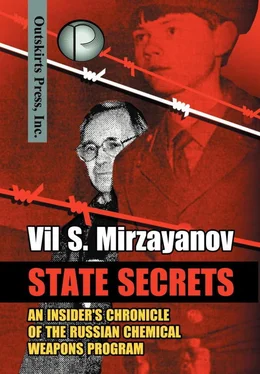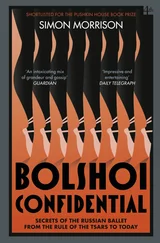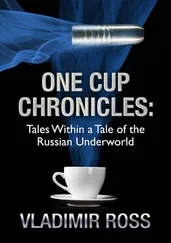Even in the prewar years, people were dying at GOSNIIOKhT from chemical agents. Healthy young men left home from the villages which were subject to total collectivization, escaping for the cities, including Moscow. According to one veteran, these poor devils were ready for any work, even at the chemical “sharashka”. The strongest and healthiest ones were urged to participate in testing the effects of chemical agents. For a few dozen rubles, some careless sturdy youngsters agreed to become guinea pigs. They didn’t suspect what kind of torture they would have to endure, before they went to a better world or became hopeless lifelong cripples, for the sake of the crazy reckless plots of the bosses of the military-chemical complex.
After my presentations about the dangerous concentrations of chemical agents in Volgograd to Victor Petrunin in October 1988, the Council on Technical Counterintelligence of the Ministry of Chemical Industry invited me to a meeting. Sergei Golubkov was the chairman of this council. I presented my report there, with all the data collected in the Volgograd NPO “Khimprom” about my findings of the unacceptable concentrations of sarin and soman in the nearby “White Sea” and in the air. After that there was a profound silence. No questions and no comments. Only GOSNIIOKhT’s Deputy Director Konstantin Guskov replied, “Vil Sultanovich did this entire job without the endorsement of GOSNIIOKhT, and his presentation is purely an unfinished scientific experiment, which should be checked and verified.” After that Golubkov gave a long speech about the importance of technical counterintelligence work, and then he lectured the audience about how to determinate traces of our newly developed substances in waste water and air, with the help of advice given by Academician Nikolai Enikolopov who had never worked a single day in this area in his life.
Some people tried to comfort me after that meeting, saying “Be happy, Vil Sultanovich! Ten years ago, they would have sent you to the camps for that, not quietly home.” It was true, but I understood entirely that my work with foreign technical counterintelligence was fiction. It was just one of a variety of Soviet deceptions, because you could easily find soman near the plant in Volgograd. That is, if you were not too lazy to look for it. Moreover, it made me feel like I was sitting at same table with ne’er-do-wells, who were incapable of doing any scientific work. I felt like I was there just to provide them with cover for their crimes against innocent people.
It was a well known fact that these people were really corrupted criminals. Even though Arvid Pelshe was a member of the Politbureau of the Central Committee of the CPSU, he published a report in the party magazine “Party Life” in December of 1987 about the investigation of the criminal actions of these people. [75] Director of Volgograd NPO Khimprom V.V. Pozdnev along with his accomplices Sergei Golubkov, Igor Gabov and Konstantin Guskov organized a lucrative underground business which produced civilian wares that were sold in stores. Cash from this scheme was flowing directly into a huge safe installed in the office of Director Pozdnev. They spent part of this money for providing “a good time” to selected people from Moscow in a special resort built for these purposes. An investigation was started, but only the head bookkeeper was sentenced to prison, and Pozdnev died of a heart attack.
At the same time, these people were continuing with their deceptive games, pretending that they were the real protectors of secrets of Soviet military complex. I already wrote about how they ordered me to develop super-sensitive methods for the determination of Novichok agents in waste water and air. Meanwhile, all the wastes from the destruction of chemical agents (including A-230 and A-232) that were used in laboratory experiments, were packaged in steel barrels, which were shipped by railway to Shikhany. There they were dumped into a hole in an open area next to the forest, where people gathered berries and mushrooms. Wasn’t it ironic that my department was ordered to determinate traces of these substances at the level of 1 ppt (part per trillion) within two months?
I tried to explain the real situation and sent Director Petrunin an official report, but there was no logic working in the system. There was a real threat that I would lose my job, on the pretext that I had ruined the State Plan for securing the military chemical complex. I don’t think that Petrunin, Guskov and the others were so stupid that they did not to understand the elementary scientific realities. It was trap set against me.
My young senior scientist Vladimir Buzaev came up with a plan to write a fictitious method, in order to placate the bosses, but I categorically refused to accept this machination, because it was impossible for me to cooperate in the destruction of my scientific integrity and personal honor. “That’s fine,” he replied. “You’ll see how they ruin you.” He was right. Petrunin called a meeting exactly two months later in late December 1988, when I sent my report to the Directorate of GOSNIIOKhT that my department couldn’t fulfill its order.
Right at the beginning, Guskov declared that I had ruined such an important governmental order on the protection our defense capabilities, so our leadership right now was in a very bad situation. There would be severe consequences for all of GOSNIIOKhT.
Deputy Director Aleksander Martynov exploded in response: “Didn’t I ask you not to appoint Mirzayanov as the chief of Foreign Technical Counterintelligence Department? You didn’t listen to me so you are picking up the harvest!”
Compared with Guskov and Martynov, Director Petrunin knew the real situation with my assignment. He was changing colors – getting red and white without any verbal reaction. Then he asked me how long it would take me to develop this method. I answered that if the entire global scientific community couldn’t do that then there would be no time period for it at all. On that note, Petrunin closed the meeting. My assistants and many people were sure that swift retaliation would come, but nothing like that happened. Nevertheless I clearly understood that I was not their man – someone who could play their games, joining in the cheating and manipulations. For them I was the ultimate stranger…
Once in 1988, in the third year of Gorbachev’s Perestroika, Petrunin was lecturing to us “stupid” scientists at one of the introductory sessions, “Any Perestroika is purely the internal business of the country. You can’t forget for a minute that the nature of capitalism hasn’t changed, and imperialism, as before, is still our most evil enemy. That is why our task is to fortify the defense power of our country. Any other attitude plays into the hands of our enemies and is criminal.”
By that time there were already many democratically minded scientists and engineers at GOSNIIOKhT. Some of them formed an organization to support Yeltsin’s democrats, and they were regulars at meetings and demonstrations against the C.P.S.U. and the opponents of Perestroika. I was one of organizers of these meetings, and this pained the Directorate greatly. Although neither the department I headed nor I were directly subordinate to the KGB, we were considered to be in its domain to a certain extent. That is why my behavior was so provocative to the Chekists. Some well-wishers from the Directorate reproached me for my excessive idealism and my impractical approach to life. However, I had already made the decision to struggle against the reigning system, particularly against the military-chemical complex. It goes without saying that I didn’t even allow myself to think about neglecting the regime of secrecy at my job.
By that time I had managed to equip my department with modern imported laboratory instruments. There were some real scientific successes as well. Among them were the preservation of chemical agents intact in solid materials such as brick, concrete, sand and others, and the development of chromatomass-spectrometric methods of analysis of these agents, as well as my special methods of extraction of these agents from solid media.
Читать дальше












